Innovate, don’t imitate — how CEOs of Sustainable Brands can leverage tailored content & turn Green to Gold
Have you noticed the number of people concerned with the planet continues to grow exponentially? Even if they don’t completely understand what’s going on, they know something needs to be done. Research and public polling back this observation up — 90% of people from the U.S. believe the government should act on climate change by planting more trees. What’s more, 77% agree on prioritizing renewable energy technologies rather than increasing fossil fuel production.
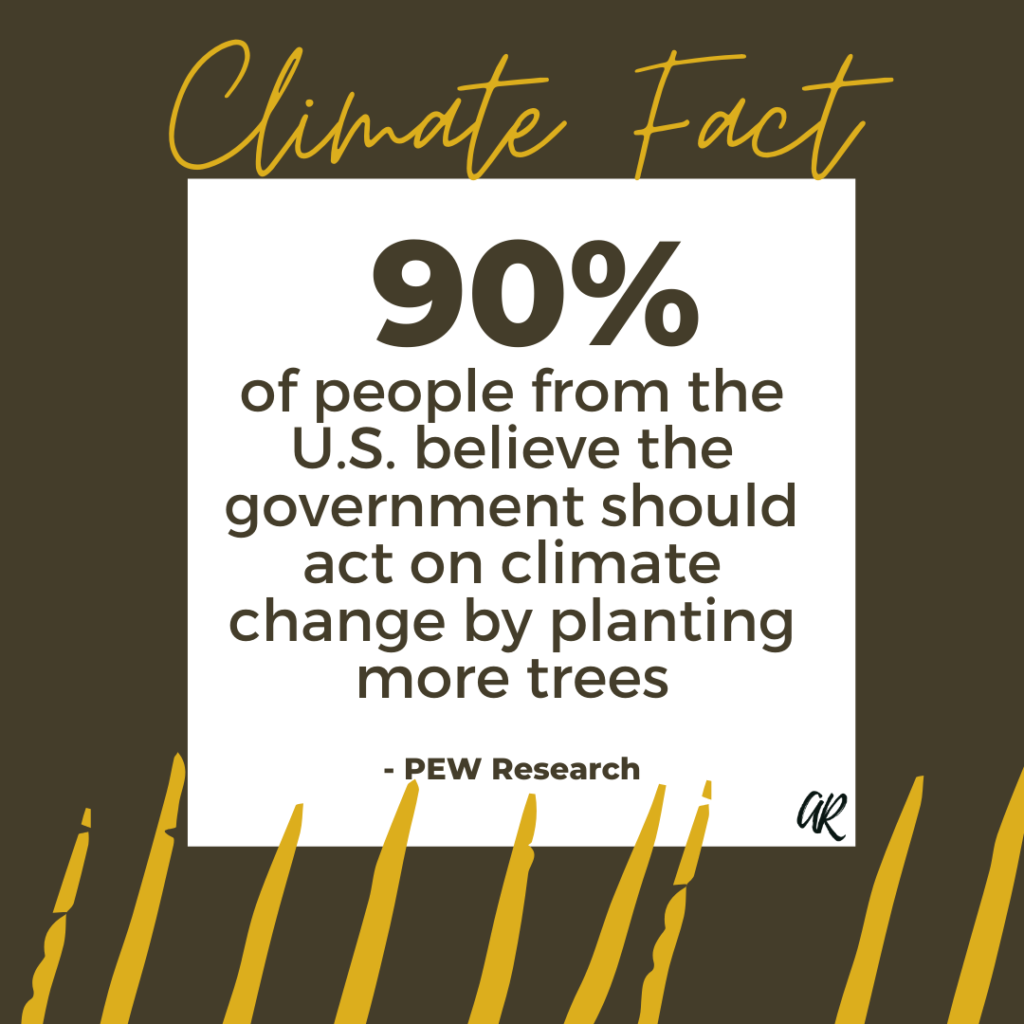

So yeah, it’s official, people care. And while our world might feel chaotic and polarized right now, it’s great to know that a public shift is taking place. In my glass-half-full vision, we will continue on this path until we have course-corrected some of the most significant human-caused planetary problems – I mean, what are the other options, really? As you can imagine, there are many intersecting reasons why this shift has occurred. Some of those reasons include everyday people seeing extreme weather events in their backyard, witnessing high rates of cancer amongst friends and family members, the evolution of respiratory diseases like SARS-CoV-2 pushing human life to the brink, and environmental injustices where people in sacrifice zones pay the highest price for corporate profits — our lives. We’ve moved away from the debate on whether environmental issues are a “sexy” enough topic to cover. People want to talk about the facts, beyond doom and gloom — and from my experience, most people want to learn and do better, whatever that means and looks like for them.
The great thing is, so many innovative environmental entrepreneurs feel the same way, which is why we’re seeing a race for innovation to solve things like plastic pollution, water shortages, dirty energy, contaminated food supplies, and climate change. Yay, innovation. And folks are ready for no-brainer switches to more sustainable, responsible ways of being. The only set back is… Trust!
Years have been wasted on aggravating corporate greenwashing, which of course continues to this day. Well-intentioned people without a background to discern are led to believe there are redeeming qualities in things like “waste to energy via incineration” and “plastic recycling.” For the record, unfortunately, there is not. These “innovations” are more like bandaids to more significant issues requiring in-depth solutions. While greenwashers abound flashing 100% plastic recycling, many more genuine solutions to preventing plastic waste are being created. The only thing is… people need help differentiating, they need trusted information from our green leaders out there. Environmental Industry leaders can’t do things the way they’ve been done before – doing good deeds quietly. As corny as it sounds, we’ve got to walk hand in hand to the future, together, loudly praising and educating on enlightened solutions that go mainstream. That’s where Environmental Content Marketing comes in.
In this post, you will learn:
- What Environmental Content Marketing is
- Why sustainable brands need a tailored Content Marketing approach
- The benefits for sustainable brands that use Content Marketing
- A new take on the standard sales funnel adapted to Sustainable Brand Content Marketing
- How your sustainable brand can develop a unique strategy
- Producing quality information and environmental education to win & keep customers while growing your environmental impact
- Personalization and relationship building for green brands
So, what exactly is Environmental Content Marketing?
Let’s start with a definition. Full disclosure, there is no standard definition of “Environmental Marketing,” let alone “Environmental Content Marketing,” so we’ve developed a working definition from our vantage point on the curve, and it goes like this:
Green Content Marketing is a type of content marketing that includes environmental education and awareness as an integral part of a marketing strategy aimed to raise environmental literacy of consumers, constituents, business to business professionals, and decision-makers about environmental issues through content creation, dissemination, and engagement; not greenwashing.
Do Sustainable Brands need a tailored Environmental Content Marketing Strategy?
Mostly Yes, but a little No.

The yes part. To steer clear of unintentional greenwashing it is best to adopt a tailored approach to content marketing for green brands. Here’s the deal, most people feel like they’ve heard it all before — that’s your enemy, a ‘been there, done that’ attitude toward most sustainable solutions. Damn those decades of greenwashing. Marketing agencies, PR agencies, website developers, and most if not all types of agencies have painted environmental products and services with the same set of brushstrokes. Banking off of a tried and true delivery method of making people feel better, happier about their new green choice – be it real or not. But we’ve come further than baseless claims and feel good campaigns. While making people feel good is nice – your claims must be based on truth, or well, that’s not very nice at all. Your brand will reflect the falsehood once customers scratch beneath the surface. But the great thing here is that you don’t have to be perfect; you just have to be transparent and plan toward achieving greater sustainability milestones with your product or service – “we’re working on that” clause but you have to mean it.
The no part. When it comes to educating on the environmental topic you are solving, people want you to stick to the facts, the science, the studies. So you can be a little more general when educating on, for example, water contamination – all the ways that water becomes contaminated and ways to filter it. There shouldn’t be fluctuation if you’re sticking to the truth. In this sense, you don’t need tailored content per say because you can share facts and stats, studies, science-based infographics. Here’s where you want to adhere to agreed upon science for the topic you’re helping people learn more about. Your job here is to make information understandable and accessible. Like with digestible facts & stats that put realities and hopes into action, like the example below.
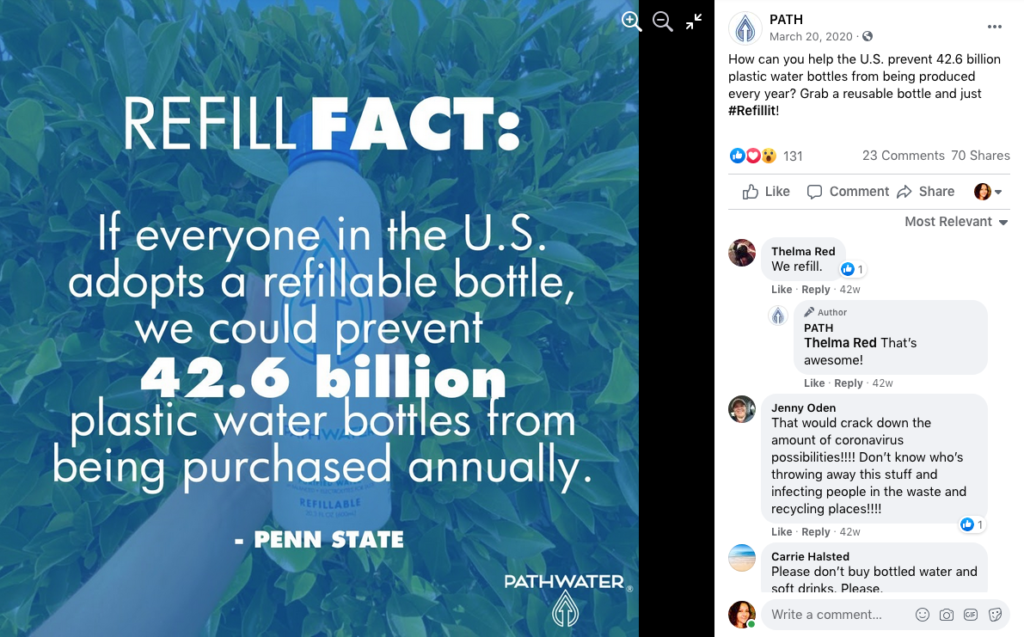
Now for more on the yes (tailored content) part.
Why does a tailored strategy matter for Sustainable Brands?

Let’s use an example here. If you’re selling non-sustainable shoes, really your biggest concerns are appealing to emotions, aesthetics, and particular feelings depending on who your brand of shoes are made for. Ultimately you’re pitching based on what owning those shoes will feel like to the wearer, not a calculable impact on the environment. A sustainable shoe brand has this opportunity to do that and much more if they want to convert people to a new way of wearing shoes. To help people “make the switch” from unsustainable shoes to sustainable shoes, they have to connect with one major thing, their why! And to connect with the why for sustainable brands means reeducation through tailored content. What does it mean to wear shoes? What can I expect from an aspirational shoe brand? What’s so bad about non-sustainable shoes anyway? If a sustainable shoe brand solely appeals to their customer on a coolness factor, that will eventually fade. Not to mention, a sustainable shoe brand won’t shine if they don’t grab the opportunity to be different and stand out, rather than market the same way as a non sustainable brand. To harness lifelong customers engaged in a brand’s mission means to bring them into a more in-depth understanding — educate on the shoe industry, compare brands, longevity, the sustainability of materials, fairness and treatment of workers, the distance of travel from factory to foot. These are all tailored topics for the sustainable shoe brand to rise to the occasion. So how will this shoe brand go about telling the stories and delivering education on these topics?
Developing a tailored content marketing strategy will require a creative approach. Often this is where a specialized agency can be outsourced to determine what that unique approach will be. Content Marketing is a long-term commitment. While the use of various content formats might vary depending on needs, the overall strategy will need to embody the brand makeup and take customers on the journey to a better life, even if that means a better life for your feet and the planet.
Maybe your sustainable brand is unsure what would best serve customers in the education and relationship-building process – you don’t want to alienate anyone, right? Experimentation and social surveys are a great way to uncover what customers want to learn about, how each customer wants to be engaged, and how they can get involved with your impact-driven brand in a way they feel fits them best.
Benefits for Sustainable Brands that produce tailored, educational content
- Build awareness for your brand as a leader, teacher, and change maker
- Teach the topics people need to understand for change and buy-in
- An opportunity to deliver transparency in a unique way
- Connect through the most effective, relevant content formats and platforms
- Grow a committed following that promotes your brand’s environmental solution
- Support sales and B2B efforts more effectively and intuitively
- Supports B2C customers along their learning and buying journeys
- Placing ads on content vs. products reduces ad spend and is seen as helpful rather than salesy
- Supports social media organically
- Open up PR opportunities organically
- Attract like-minded partners to join your cause
- Improved SEO
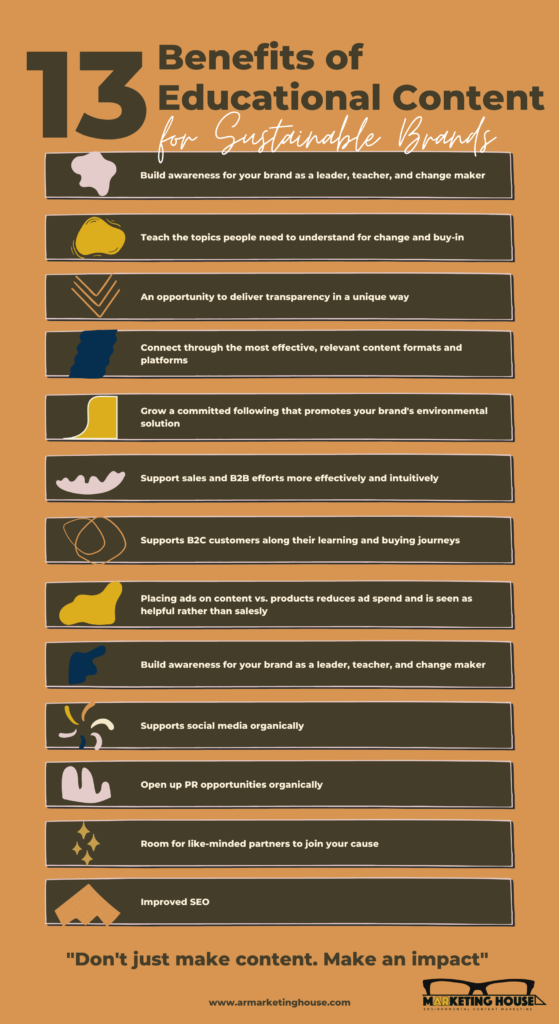
How is Content Marketing different for Sustainable Brands?
While ROI is the name of the game for any company or organization, a sustainable brand’s measurable impact is inextricably tied to this ROI. For sustainable brands that have embedded their success into their impact on the planet, there’s no escaping that education through content marketing will aid on this mission. Helping customers “switch over” and convert their friends and family to, for example, toxic-free laundry practices, reusable coffee pods, investing in solar panels, etc. For sustainable brands that have a B2B market, it also takes education to help B2B buyers update their supply chains and truly understand your solution’s entire lifecycle and how your solution will help their company’s triple bottom line, or ESG (environmental, social, governance) goals.
Based on the premise of a typical sales funnel, we’ve created an Environmental Content Marketing funnel that gives context to each stage in relation to the advancement of an environmental solution. Starting from the top of the funnel:

Stage 1 involves reeducation, which is the awareness stage. Hey! Teach people something new, right? That’s the idea here, to get people to think of concepts related to your solutions in ways they’ve never thought about before. Here’s where the reframing and new metaphors come in, take the topic, and rework how people think of it, whether through metaphors or using a new language. Linguist George Lakoff calls this “framing,” and you can learn more about it in Framing: 6 Lessons for Marketing Teams of Sustainable Brands.
Stage 2 is typically called the consideration stage; for sustainable brands, this looks more like transparency, social proof, and everything you have to lay out on the table to build trust. If there’s an aspect of your product or service that might stir up confusion or isn’t quite as green as you’d like, here’s where you can come clean and discuss it rather than tucking it away like a nasty little greenwasher, eh? You’ll build trust with your followers for calling out the things you’re working to improve.
Stage 3 is the a-ha moment for your new customers. They’ve “made the switch” and see your offering as a solution.
Stage 4 is the proof that you’ve done your job educating, and they see your solution as long-term, something they can’t turn back from now.
Stage 5 is the “why doesn’t everyone know this” stage. At this point, you’ve successfully guided your customers along the knowledge journey to take action, and they can’t believe others are not doing the same. Now is the time to give them the tools to make an impact on the lives of their business partners, friends, and family. Here is where your ROI and measurable impact become exponentially powerful by helping your customers take promotional action, i.e., becoming the teachers.
Looking at the sales funnel in this context, you can start to ask, just how is your community supported along each stage of the journey toward a better life and planet?
Environmental Content Marketing is not only about a campaign, it’s a commitment that deserves its own Mission Statement (yep!)

While all marketing strategies have their place, content marketing is not a one and done marketing model. Unlike PR campaigns, ad campaigns, product promos, etc., that are produced once and the benefits are acutely measured and analyzed for success, content marketing is more like an asset that you can continually draw from. Campaigns can be supported by content, but your environmental content strategy will continue to support your efforts even if it shifts in format over time. Whereas once an ad has completed its deadline, stellar content can continue to draw traffic, shares, and awareness for years to come, as long as you continue to strategically disseminate and promote the content, keeping it fresh and relevant.
The commitment for sustainable brands is really in the educational and entertainment aspects. Emphasis on the educational, there are wild myths that still exist around environmental topics. Here are just a few:
- The damage is done; there’s nothing we can do
- Nature and ecosystems are “out there” and not relevant to me
- Plastic is recyclable, so I don’t need to stop using it
- Climate change isn’t real, it’s naturally occurring, and there’s nothing we should do
There are so many other myths, and in all fairness, as science is continually evolving, it’s our job as educators and problem solvers to deliver updates on these topics. The fact remains, there’s still so much knowledge sharing to do if we’re to course-correct toward zero-waste, renewable energy, clean equitable water access, sustainable food, and reforestation.
Education can’t just be for customers; we need all hands on deck where content marketing is concerned. When the level of environmental literacy is lifted in your particular sector, you will have knowledgeable, confident stakeholders, employees, c-suite executives, investors, and partners. Knowing not just how to change but also why a change is needed helps solidify those learning moments and make the learning curve a bit easier.
Now time for that Environmental Content Mission Statement. Having a mission statement for your content will tie in the most critical aspects of your team’s content creation for your brand’s community. The winning formula looks something like this:
[Name of Company/Organization] is dedicated to delivering [types of content] on the topics of [list content pillars] to achieve [goals for your customers].
To see this example in context, here is the A.R. Environmental Content Marketing House content mission statement:
A.R. Environmental Content Marketing House will consistently produce content for CEOs and CMOs of environmental companies on environmental content marketing topics to help grow their business, accomplish their mission, and increase their measurable impact on the planet.
Overcoming pain points and barriers

It’s easy to say, “Yah, I love content; let’s get some blogs and videos going – what eco topics do we want to cover?” But having a passion for content and delivering a winning strategy that covers all bases while elevating your eco brand to the next level are two different approaches. Especially with environmental topics, there are some hurdles to cross. Por ejemplo (that’s Spanish for “for example” ):
It’s not always easy for everyone to readily understand the science, or the need for your environmental solution, and that’s okay. The sad reality is whether your product or service is B2B, B2C, solving water issues, taking climate action, or tackling waste, most people have not received the environmental education necessary to make a sound, un-greenwashed decision. They need reliable, fact-based information delivered to them in comprehensive ways to move forward to incorporate genuine sustainability.
Everything is connected, which is why including a multidisciplinary approach when discussing environmental topics in your content is powerful. To properly discuss, for example, the plastic crisis, tie in multiple issues that affect its current state like fossil fuels, photodegradation, the endocrine system, oceanic food chain. Leave the doom and gloom behind; taking a multidisciplinary fact-based approach to explaining topics respects your customers’ intelligence and helps them understand how systems are related.
Focusing on the right kind of engagement. Engagement is all about participating in a dialogue that your community wants to have. So you put your ears to the online forums and social media conversations to see what questions are being asked. Search what misperceptions are being spread, and start creating content around these complex topics by simplifying them and facilitating conversations across your channels.
Preaching to the sustainable choir. Love the choir; they’re great but don’t stop at preaching to people who are already believers; your brand likely needs new leads and nudges over those on the fence. Delve into your buyer personas, make sure they’re not too narrow, and craft strategies that reach beyond the heavy believers. They’re going to want more proof, more science, more effort from your content team. And you’re going to give it to them because that’s how you’ll make an impact while increasing your growth.
How do you create a unique Environmental Content Marketing strategy?

There are many steps to take in developing a unique strategy, enough to write an entire eBook on (hint drop succeeded) — when it comes to sustainable brands, here are a few factors to consider. Remember, you’ll want to dive into these questions while thinking of how you would connect and deliver content that addresses these questions’ answers in unique, compelling ways.
What is your unique solution? What sets it apart from other solutions? Why is it superior, and what are the big selling points? How are you saving the planet? What proof can you show? When you think of the answers to these questions, consider the creative ways you can express these features, how would you describe them, how would you represent them without words?
Who are your target personas? Do not start your Environmental Content journey without knowing precisely who you are trying to reach. When exploring your buyer personas, make them as real as possible. Give your buyer personas names, talk to them in real life, and learn what they care about and their values. Beyond the usual demographics, which may or may not be helpful (they might just be stereotypes) — talk directly to people who embody your mission and brand. Learn where they hang out online and offline, and find out about those key points that had them make “the switch” to your brand or solution. Rinse and repeat until you have about 5 personas. You don’t need much more than 5 core personas; if you have more, you may find that they overlap in very subtle, unimportant ways. Spend more time intimately getting to know the 5, rather than creating 15.
Producing quality environmental content
Now that your strategy is locked and loaded, you’ve narrowed down your personas, you have a tailored approach with some content pillars and an environmental content mission statement, it’s time to set up your content management system and get to creating—some pointers before getting started.

Take your unique strategy and make stellar content. Don’t settle for cheap, poorly researched written blogs, blasé downloadables, or half-cooked content ideas. Aim high on the quality of your content whether you have an in-house team or you get outsourced help, use a brand editorial and content style guide and make sure all content creators know your content mission statement intimately before creating content.
Invest in your content as an asset for your brand that will continue to deliver and grow. Some companies like Disney are built on content as assets. That’s because they’re high quality and have a high value. The mindset of investing in the content will garner more ROI and impact your brand in the long run.
Measure your Environmental Content and understand your long-term ROI. Quality content might cost a little more upfront but pays hands-down for getting the best ROI. On the other hand, lower budget content or content lacking a strategy may actually hurt your brand, and you could risk losing customers if they find your content to be subpar, as it reflects your products and services.
 Going beyond – environmental content personalization builds relationships
Going beyond – environmental content personalization builds relationships
The experiences that you give your customers are the imprints that will stick with them. When it comes to environmental education, you want to make sure customer voices are heard, their questions thoroughly and honestly answered – you know, kind of like a bff. You want to have the right content and the right CRM software in place so that each customer feels like you’re speaking directly to them across the channels they prefer. Weaving environmental content into communications is an ongoing process. Never stop the conversation, and never stop making an impact.

 Denise Anderson-Rivas is the Director of Environmental Education & Co-founder at A.R. Environmental Content Marketing House. Denise helps clients successfully merge the mutual needs of Environmental Content Marketing and Environmental Education. Powered by her multi-disciplined background in science, business, marketing, and natural resource conservation, she is committed to raising the level of Environmental Literacy for all, improving quality of life and decision making on sustainability and environmental justice topics.
Denise Anderson-Rivas is the Director of Environmental Education & Co-founder at A.R. Environmental Content Marketing House. Denise helps clients successfully merge the mutual needs of Environmental Content Marketing and Environmental Education. Powered by her multi-disciplined background in science, business, marketing, and natural resource conservation, she is committed to raising the level of Environmental Literacy for all, improving quality of life and decision making on sustainability and environmental justice topics.
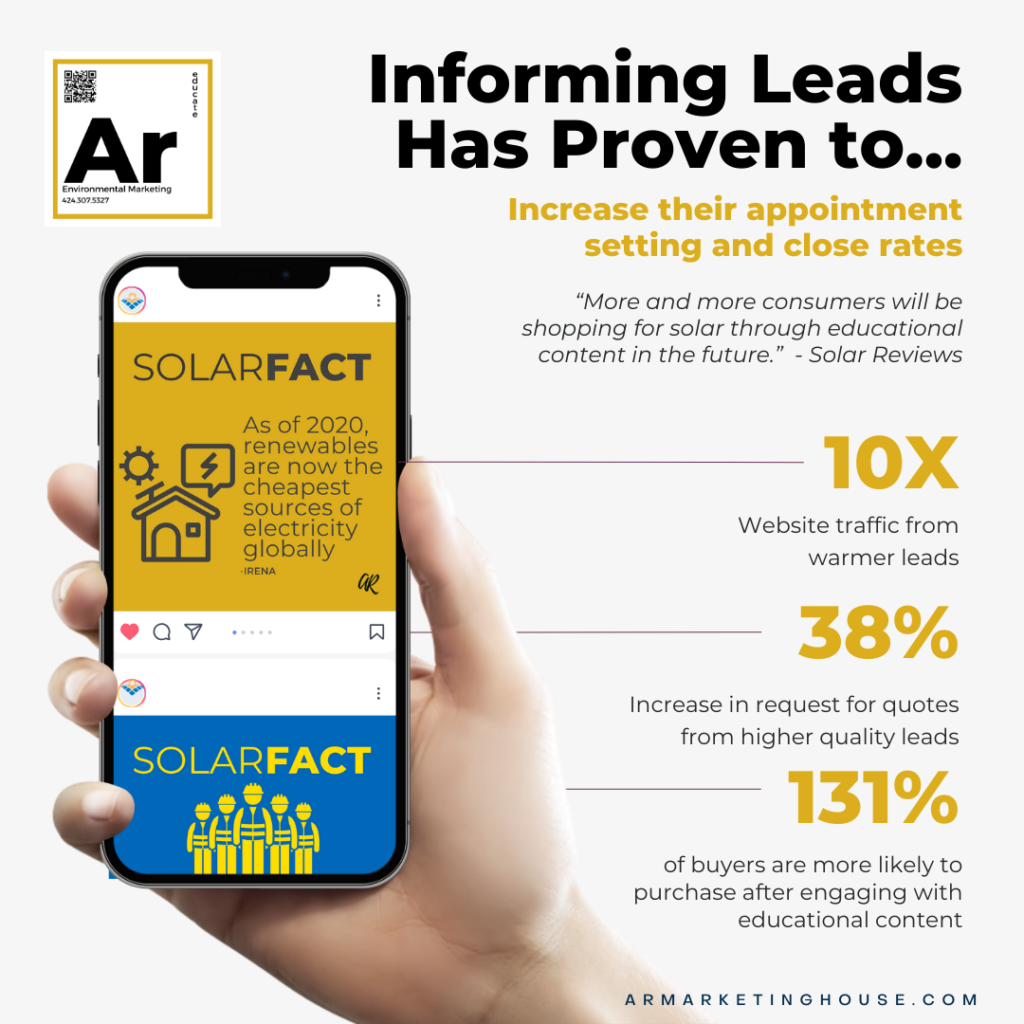
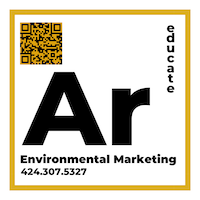
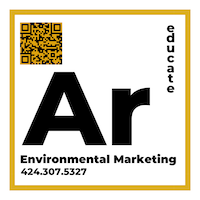









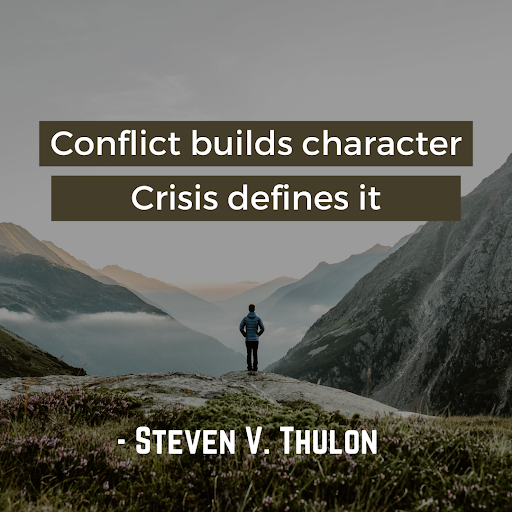

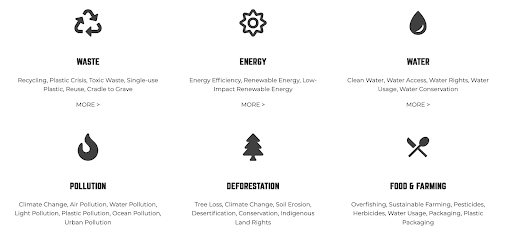

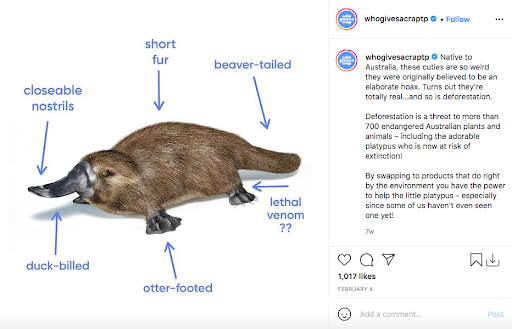

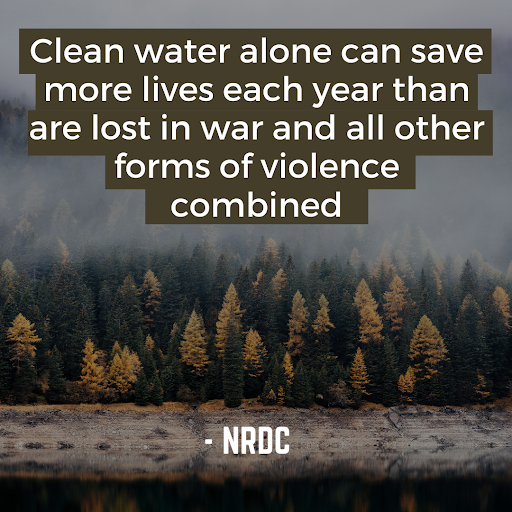

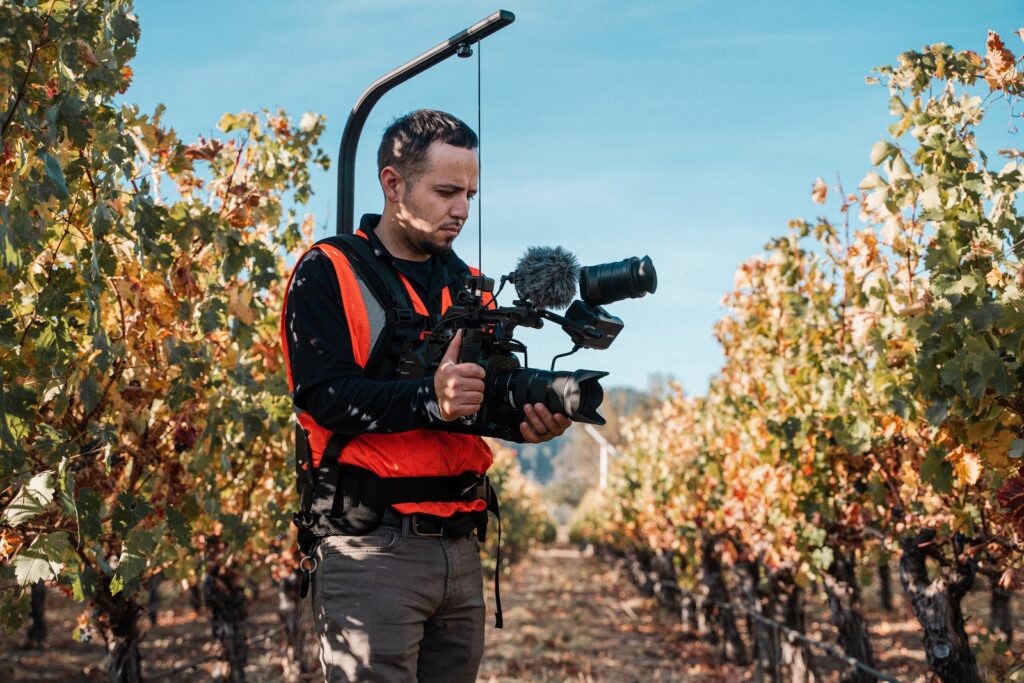












 Going beyond – environmental content personalization builds relationships
Going beyond – environmental content personalization builds relationships
 Denise Anderson-Rivas
Denise Anderson-Rivas